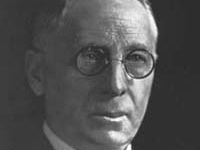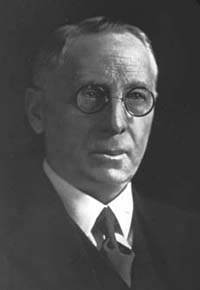
DAVID ADAMS takes a look at the life of the founder of the Australian Inland Mission and the Royal Flying Doctor Service…
A Presbyterian Minister in the early half of the 20th century, Rev John Flynn’s heart for remote outback communities led him to found both the Australian Inland Mission and the world’s first air ambulance service – the Royal Flying Doctor Service.
Born on 25th November, 1880, in the now mostly deserted Gold Rush town of Moliagul, Victoria, Flynn was the third child of school teacher Thomas Flynn and his wife Rosetta.

Rev John Flynn, c 1929. PICTURE: Wikipedia.
His mother died in childbirth when he was just three and as a result Flynn spent part of his childhood with relatives before the family moved to the western suburbs of Melbourne where his father took a job as a head teacher.
Flynn went on to study at University High School and after graduation, unable to afford to attend university, followed in his father’s footsteps and worked as a secondary school teacher for five years.
Having at some stage decided to become a Presbyterian minister, in 1903 he began training for the ministry and, while doing so, served at Beech Forest in the Otway Ranges and at Buchan in East Gippsland. In 1907, he entered the Presbyterian Theological Hall at Ormond College (a college of the University of Melbourne) to study divinity.
That same year he published The Bushman’s Companion – a small volume written for the benefit of outback residents and containing information on subjects like first aid, Bible readings and a calendar (you can access a complete copy here: www.nla.gov.au/apps/doview/nla.aus-vn4665273-p.pdf).
Ordained a minister of the Presbyterian Church in Adelaide, South Australia, in 1911, Rev Flynn then took a position at the Smith of Dunesk Mission in the northern Flinders Ranges, about 500 kilometres north of Adelaide, where he ministered at the surrounding stations.
In 1912 – following his submission of two reports detailing at length the needs of white settlers and Aboriginals in the Northern Territory – he was appointed the first superintendant of the Australian Inland Mission to minister to the needs of the Outback people – spiritually, socially and medically – with the first base being the Oodnadatta Nursing Hostel which had opened the previous year. The operation commenced with just one nursing sister, one padre, and five camels.
In the following years, nursing hostels were established in Port Hedland and Broome in Western Australia, Pine Creek in the Northern Territory and Cloncurry in Queensland.
Meanwhile Rev Flynn – inspired by a letter he received in 1917 from Lieutenant Clifford Peel of the Australian Flying Corps, a Victorian medical student serving in World War I (he died at the age of 24 after being shot down in France) – had started thinking about using aircraft to reach people with medical assistance in remote areas and the importance of the wireless to provide the link between doctor and patient.
Rev Flynn started campaigning for an aerial medical service and, following a substantial bequest from a long-time supporter and the signing of an agreement with Qantas’s Hudson Fysh (one of the airline’s founders and its first managing director), in 1928 he was able to establish an aerial medical service. The inaugural flight of the Victory – a De Havilland 50 bi-plane piloted by Arthur Affleck with a Dr Kenyon St Vincent Welch on board – took off from Cloncurry in Queensland on 17th May.
In 1931, at the age of 51 Rev Flynn married Jean Baird, secretary of the Australian Inland Mission. Meanwhile, guiding the organisation through the Great Depression, he continued to lobby government and the church to take the new service Australia-wide.
In 1934, this resulted in the formation of the Australian Aerial Medical Service which went on to establish a network of bases across the country. It was this organisation which later became the Royal Flying Doctor Service (the name was changed to the Flying Doctor Service of Australia in 1942 and the ‘Royal’ was added in 1955). The effectiveness of the service was ensured by the invention, in 1929, of Alfred Traeger’s pedal radio which enabled remote families to communicate across great distances.
In 1939, Flynn (who had been awarded an OBE in 1933), was elected to the role of moderator-general of the Presbyterian Church of Australia for three years.
He died of cancer on 5th May, 1951, in Sydney, and was cremated. His ashes were then taken and placed under a large boulder at the foot of Mt Gillen near Alice Springs (the rock has since been replaced).
Flynn’s legacy lives on today, not just through the organizations he was instrumental in founding, but through the approach he took to their establishment. Not only do numerous institutions in Australia now bear his name, he was honored with an appearance on the $20 banknote.
An inspiring figure in Australia’s history, there is a dedicated museum and art gallery to Flynn in Conclurry, Queensland (www.johnflynnplace.com.au). There’s also a Flynn heritage trail (www.flynntrail.org.au) which links together some of the historic sites in Flynn’s story.
SOURCES AND FURTHER INFORMATION:
• ‘The John Flynn Story’ on the website of The Royal Flying Doctor Service
• ‘John Flynn’ – Australian Dictionary of Biography





